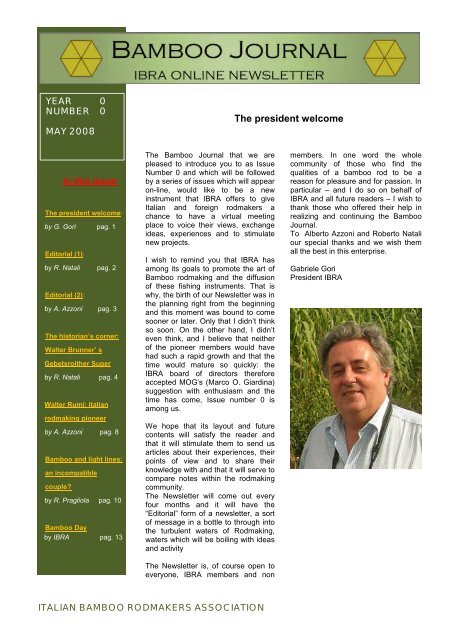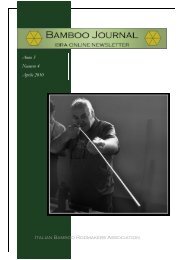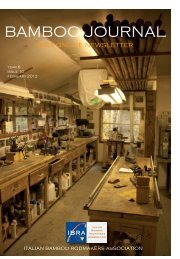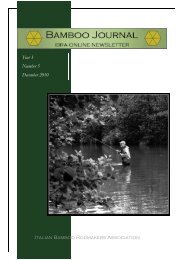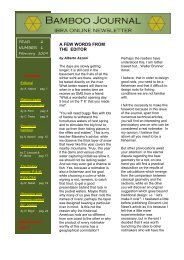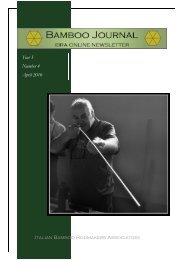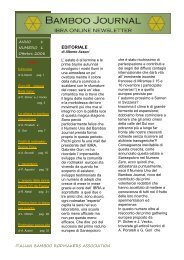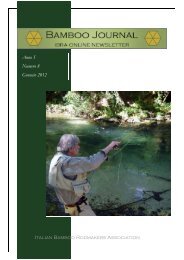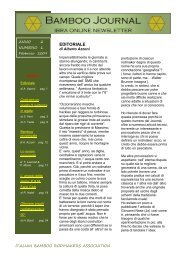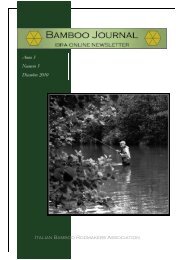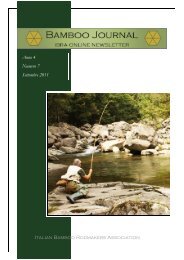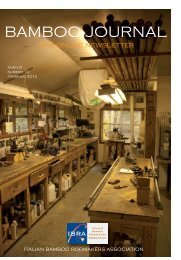The president welcome
The president welcome
The president welcome
Create successful ePaper yourself
Turn your PDF publications into a flip-book with our unique Google optimized e-Paper software.
YEAR 0<br />
NUMBER 0<br />
MAY 2008<br />
<strong>The</strong> <strong>president</strong> <strong>welcome</strong><br />
In this issue:<br />
<strong>The</strong> <strong>president</strong> <strong>welcome</strong>:<br />
by G. Gori pag. 1<br />
Editorial (1):<br />
by R. Natali pag. 2<br />
Editorial (2):<br />
by A. Azzoni pag. 3<br />
<strong>The</strong> historian’s corner:<br />
Walter Brunner’s<br />
Gebetsroither Super<br />
by R. Natali pag. 4<br />
Walter Rumi: italian<br />
rodmaking pioneer<br />
by A. Azzoni pag. 8<br />
Bamboo and light lines:<br />
an incompatible<br />
couple?<br />
by R. Pragliola pag. 10<br />
Bamboo Day<br />
by IBRA pag. 13<br />
<strong>The</strong> Bamboo Journal that we are<br />
pleased to introduce you to as Issue<br />
Number 0 and which will be followed<br />
by a series of issues which will appear<br />
on-line, would like to be a new<br />
instrument that IBRA offers to give<br />
Italian and foreign rodmakers a<br />
chance to have a virtual meeting<br />
place to voice their views, exchange<br />
ideas, experiences and to stimulate<br />
new projects.<br />
I wish to remind you that IBRA has<br />
among its goals to promote the art of<br />
Bamboo rodmaking and the diffusion<br />
of these fishing instruments. That is<br />
why, the birth of our Newsletter was in<br />
the planning right from the beginning<br />
and this moment was bound to come<br />
sooner or later. Only that I didn’t think<br />
so soon. On the other hand, I didn’t<br />
even think, and I believe that neither<br />
of the pioneer members would have<br />
had such a rapid growth and that the<br />
time would mature so quickly: the<br />
IBRA board of directors therefore<br />
accepted MOG’s (Marco O. Giardina)<br />
suggestion with enthusiasm and the<br />
time has come, Issue number 0 is<br />
among us.<br />
We hope that its layout and future<br />
contents will satisfy the reader and<br />
that it will stimulate them to send us<br />
articles about their experiences, their<br />
points of view and to share their<br />
knowledge with and that it will serve to<br />
compare notes within the rodmaking<br />
community.<br />
<strong>The</strong> Newsletter will come out every<br />
four months and it will have the<br />
“Editorial” form of a newsletter, a sort<br />
of message in a bottle to through into<br />
the turbulent waters of Rodmaking,<br />
waters which will be boiling with ideas<br />
and activity<br />
<strong>The</strong> Newsletter is, of course open to<br />
everyone, IBRA members and non<br />
members. In one word the whole<br />
community of those who find the<br />
qualities of a bamboo rod to be a<br />
reason for pleasure and for passion. In<br />
particular – and I do so on behalf of<br />
IBRA and all future readers – I wish to<br />
thank those who offered their help in<br />
realizing and continuing the Bamboo<br />
Journal.<br />
To Alberto Azzoni and Roberto Natali<br />
our special thanks and we wish them<br />
all the best in this enterprise.<br />
Gabriele Gori<br />
President IBRA<br />
ITALIAN BAMBOO RODMAKERS ASSOCIATION
Bamboo Journal Page 2<br />
Editorial (1)<br />
When the President asked me to give Alberto Azzoni a<br />
hand in drawing up an IBRA newsletter, I was quite<br />
surprised and flattered and my first impulse was that to<br />
decline. I am one of the last people to join IBRA and as<br />
a Rodmaker I have only ever made my Number one<br />
during the last IBRA Rodmakers’class and so I felt that<br />
I should only read about Rodmaking rather than write<br />
about it. However when the President said “you can<br />
give us your contribution in its making and take care of<br />
the historical part of Rodmaking”, I accepted because,<br />
when five years ago I was lent a Pezon & Michel (8’6”<br />
Parabolic Normal) I was “struck” by bamboo and from<br />
then I’ve spent a small fortune (for my possibilities) in<br />
collecting European Bamboo rods (mainly) and some<br />
American ones too.<br />
Since I was faced with the need to do a lot of<br />
restoration work, I started collecting books on collecting<br />
and I started studying Rodmaking with extreme<br />
difficultly mainly because of my scarce knowledge of<br />
English and I eventually decided to attend the IBRA<br />
Rodmaking Class. So I do not consider myself an<br />
“expert” but rather a simple collector with a passion who<br />
get great pleasure from fishing with a rod made 50 - 70<br />
years ago: I use a Hardy Palakona (a mythical 8’5<br />
weight Phantom) made in 1957 (the year I was born<br />
in) that is in a lot better conditions than I am and often a<br />
7 ‘4 weight HI Prince which dates to the beginning of<br />
the 50’s. As a collector, I have surely got a few loose<br />
screws especially due to the fact that I recently won an<br />
auction for an 8’Hardy CC de France which is dated<br />
1910! Just think what it’s like fishing with a rod that is 98<br />
years old!<br />
My good friend Moreno says that once I start fishing<br />
with my own rods, I will be “healed”, but I have serious<br />
doubts. I hope my collaboration will serve IBRA and I<br />
hope the experts” (the real ones) will forgive my<br />
inaccuracy when I discuss the various Rodmakers and<br />
their work.<br />
I also hope that my articles on rods that have made<br />
history will be of interest to you and to further stimulate<br />
your interests, I will try to publish the taper of every rod<br />
I will discuss in case you were to decide to make one.<br />
Roberto Natali<br />
ITALIAN BAMBOO RODMAKERS ASSOCIATION
Page 3<br />
EDITORIAL (2)<br />
Bamboo Journal<br />
Bamboo Journal<br />
Dear Friends<br />
This is the first issue, the Number Zero”of “ <strong>The</strong><br />
Bamboo Journal “, a Newsletter that will be<br />
issued every 4 months and which will be available<br />
on the IBRA website and it can be downloaded<br />
directly to your computer. This project stems<br />
directly from an initiative by our untiring President<br />
– Gabriele Gori who last winter with an<br />
unexpected phone call, offered me the position of<br />
editor. So it was either the surprise of the offer or<br />
perhaps because on the spur of the moment I<br />
couldn’t find any plausible excuses to decline,<br />
also because the idea to have the opportunity of<br />
getting to know the small and big rodmakers’<br />
secrets first hand, made me accept willingly and I<br />
must admit I was quite honoured. Roberto Natali,<br />
whose greeting you will read later, will share this<br />
role with me.<br />
We belong to a relatively young community, most<br />
of us met for the first time three years ago in<br />
Sansepolcro and we have grown a lot. We have<br />
broaden our horizons and there will be new<br />
projects; we were only missing an official voice<br />
which would be to find by all and since the<br />
Internet offers this opportunity it would be a pity to<br />
not take advantage.<br />
I wrote that you will be able to find this magazine<br />
(or better still Newsletter) but the fact that it will<br />
exist depends exclusively on you: we are all part<br />
of the staff, the container is empty and we need to<br />
fill it up with our articles.<br />
What can we read/write on the Bamboo Journal? I<br />
don’t think you need my advice; perhaps we will<br />
not be so different to our mother/sister form<br />
overseas “Power Fibres” but if what J.D. Wagner<br />
wrote after the 2007 International German<br />
Rodmakers’Meeting: <strong>The</strong> Europeans are leading<br />
the way in inventive techniques and styles in their<br />
everyday work”, perhaps we do have something<br />
to talk about.<br />
In this issue, a part from Gabriele Gori’s greeting,<br />
a homage to Walter Rumi, one of the pioneer<br />
Italian rodmakers to whom quite a few of us owe<br />
something, then Roberto Pragliola’s ideas on<br />
bamboo and he knows something about casting –<br />
he is literally a Master Caster and finally an article<br />
about an historical rod made by an historical<br />
European Rodmaker – the Gebetsroither Super<br />
by Walter Brunner.<br />
Yes, the subject matter could be this one:<br />
important people in the Rodmaking world or fly<br />
fishers who have some connection to our beloved<br />
rods: descriptions of historical rods or at least<br />
interesting for some reason and above all articles<br />
on taper design and the construction of rods, tools<br />
or machines that clutter up our workshops. We will<br />
publish reports about gatherings, reviews about<br />
book and magazine that deal with Bamboo.<br />
<strong>The</strong> Newsletter will be published every quarter …<br />
if we have material and will be available in Italian<br />
and English. I invite you to not hesitate and to<br />
send us whatever you feel could be of interest; do<br />
not worry about it being commonplace, everyone<br />
remembers when at the beginning every small<br />
step forward cause perplexity. If, in your desk you<br />
have a small secret that will solve a small problem<br />
do not hesitate to make it known to someone who<br />
is looking just for that solution. If instead you’ve<br />
discovered the taper for the “ideal rod” bring it<br />
before the cruel justice of our world of<br />
perfectionists.<br />
<strong>The</strong> one thing that strikes me every time I meet<br />
the more expert rodmakers is how willing they are<br />
to share their knowledge and also the extreme<br />
ease with which they explain concepts and<br />
procedures that are apparently difficult. I hope to<br />
find in these pages the same communicative<br />
strength and the willingness to share experiences<br />
that has made every gathering a real enriching<br />
occasion both from a personal and a technical<br />
point of view.<br />
Send your articles in the language you prefer (we<br />
should be able to traslate the most common<br />
ones), possibly in a Word format to<br />
editor@rodmakers.it<br />
Alberto Azzoni<br />
ITALIAN BAMBOO RODMAKERS ASSOCIATION
Bamboo Journal Page 4<br />
“<strong>The</strong> Historian’s Corner”<br />
<strong>The</strong> Gebtsroither Super by Walter Brunner<br />
It’s not easy to start writing a column, let alone doing it in a Newsletter for Rodmakers! Just think how many<br />
famous Rodmakers and legendary rods have written the history of fly fishing, so much so that many modern<br />
Rodmakers are still using classical and time tested tapers by Payne, Dickerson, Garrison, Gillum, Leonard,<br />
etc.<br />
Even the modern Italian rodmakers have begun with famous tapers just as the modern American Rodmakers<br />
have done before them – Cattanach, Gould etc., this is also due to the fact that the literature which was<br />
available to the Italian pioneers was all American! In Europe there was however a Rodmaker whose fame<br />
and capacity was comparable with the great American Rodmakers: Walter Brunner.<br />
Brunner during the final phases of a catch when he suggest to turn<br />
the rod by 180° to compensate for the stress the rod has to undergo<br />
during the initial fight with a fish.<br />
” Glass case with some of Walter Brunner’s works<br />
of art at the ’Österreichische Fischereigesellschaft,<br />
gegr. 1880<br />
Walter Brunner (b. 2/04/1927 – d. 26/01/2007) was<br />
without doubt the greatest European Rodmakers,<br />
excluding the industries like Hardy and Pezon & Michel.<br />
He was also the only one to make rods continuously<br />
from 1963 to 2007! Another characteristic of Brunner’s<br />
production is that his first rods were developed in<br />
collaboration with great fly casters (the Austrian Hans<br />
Gebetsroither and the Swiss Hans Reiter Hebeisen )<br />
who theorized on a casting technique that was totally<br />
“different” to the classical English and American casting<br />
styles and which was based on short but powerful rods.<br />
ITALIAN BAMBOO RODMAKERS ASSOCIATION
Page 5<br />
Bamboo Journal<br />
Bamboo Journal<br />
Hans Gebetsroither, Heidi Hebeisen and<br />
HR Hebeisen<br />
Similar techniques are still taught in Switzerland by HR Hebeisen<br />
(Swiss Casting Club), who has been the world casting champion<br />
various times with a personal record of 62,73 metres (1969), in<br />
Austria by Hans Aigner (Erste Gebetsroither<br />
Fliegenfischerschule – Gebetsroither School of Fly Fishing) and<br />
by Roman Moser (Roman Moser Casting-Clinic).<br />
History tells us that Walter Brunner became interested in fly<br />
fishing after the Second World War and built all his own<br />
equipment to make his first fly rods, having acquired the passion<br />
when he met an English fly fisherman on the Traun in 1949.<br />
After years of experimentation and the discovery of heat<br />
treatment, in 1961 he met Hans Gebetsroither who was struck by<br />
the quality of his rods and two years later, after the death of his<br />
boss, decided to dedicate his life totally to rodmaking and<br />
founded the company “Brunner-Austria Fliegenruten”. In 1964 his<br />
production had reached 100 pieces per year and much of the work is carried out on machines he made<br />
himself. Later on the use of machinery was reduced in order to achieve greater quality and at the end of the<br />
90’s, the production was around 50-60 rods a year..<br />
Brunner splitting a culm next to a 60° beveller built in 1964 and<br />
during node treatment.<br />
<strong>The</strong> collaboration with Hans Gebetsroither was<br />
fundamental for his first series of rods which was<br />
called “Wildwasser” and which consisted in models<br />
which remained in his catalogue for his whole<br />
rodmaking life: Cheri, Gebetsroither, Gebetsroither<br />
Super, Traun e Traun Spezial. <strong>The</strong> rods in this series<br />
are characterized by a very fast action, and they can<br />
be distinguished well for having the butt section<br />
length different to the tip section; they have black<br />
wrappings with either an all cork reel seat with black<br />
hardware or a cork handle with black screw locking<br />
reel seat. <strong>The</strong>y normally came with one tip, a green<br />
rod sock with a label that bore the rod details and a black rod tube with leather latches.<br />
<strong>The</strong> rod I will describe is the Gebetsroither Super, a “stiff pole” 2,00 metres long (Brunner rods are European<br />
and they were measured in metric) for 5/6 weight. This is one of the famous rods which were developed in<br />
collaboration with the famous Traun river keeper and you can understand it’s action only when you think<br />
about that river, its width, the immense flow of water and its great fish (at least until it remained one of the<br />
ITALIAN BAMBOO RODMAKERS ASSOCIATION
Bamboo Journal Page 6<br />
great rivers of the world). Many times, when Roberto Pragliola used to say that Bamboo was no good for his<br />
TLT style of casting, I would think “you have never tried a Gebetsroither Super” but then the IRP ( IBRA<br />
PRAGLIOLA rod) was born and when I tried it I thought “ it’s slower than a Gebetsroither Super”, but I’m not<br />
a good caster so consider these “as the impressions of a bad caster”. <strong>The</strong> rod was made continuously<br />
between 1963 to 2007 – for 44 years and it is the easiest Brunner rod<br />
to find with prices that go from €700 to €1.200 according to the<br />
conditions and on whether it has one or two tips (rare because these<br />
were only made to order). At least two versions were made and they<br />
are distinguishable by a different reel seat, either all cork with a weight<br />
of 85 grams or with screw locking reel seat which weighs 105 grams.<br />
<strong>The</strong> rods are hand signed in black ink with the name “Brunner –<br />
Austria” “Type<br />
Gebetsroither<br />
Super” “ 2,00m”<br />
and “85 g.” or<br />
“105 g ”. Each<br />
rod also has a<br />
code composed<br />
of the month and year and often a progressive number of the rod: e.g. if<br />
you find 572/54 written, this means that it is rod number 54 made in<br />
May of 1972; if you find written 12/80, the rod was made in December<br />
of 1980. <strong>The</strong> code if often written under the<br />
A “Wildwasser “ rod with tube and label<br />
main signature or above the hook keeper<br />
or more often in front of the handle<br />
between the two wrappings of the hook<br />
keeper. <strong>The</strong> ferrules have been browned and the wrapping made with black<br />
Gudebrod nylon with double wrapping on the curve of the guides<br />
(like Pezon & Michel, you may note the bulge in the photo), the<br />
stripping guide and tip top are in hard chromium and 6 snake guides but I do<br />
not know who supplied these. <strong>The</strong> rods are hand varnished and the quality<br />
is impeccable. On the whole it is a simple and elegant rod and I hope it has<br />
stimulated your fantasy.<br />
Brunner used a mill because he declared that in this way he could guarantee<br />
a more uniform and precise production, so I have no knowledge about what<br />
method he used to design his models; the taper I have attached was<br />
measured directly on a rod I own (a 1971 version with the screw locking seat)<br />
directly on the classical planing form stations and averaging the<br />
measurements obtained on the faces and they include the varnish. <strong>The</strong><br />
sections are quite precise. I inserted the data in RodDna to get the dimension<br />
chart and the stress curve.<br />
ITALIAN BAMBOO RODMAKERS ASSOCIATION
<strong>The</strong> results confirm the precision of the taper which was obtained using a mechanical mill.<br />
Roberto Natali<br />
River Traun ( Austria ) where Brunner’s Gebetsroither Super was born<br />
Le fotografie di questo articolo sono tratte da:<br />
http://www.freundedergmundnertraun.at/ - cataloghi Brunner - sito web OIFG 1883 - sito web Hebeisen<br />
ITALIAN BAMBOO RODMAKERS ASSOCIATION
Bamboo Journal Page 8<br />
Walter Rumi: Italian rodmaking pioneer<br />
every nook and cranny and one gets the urge to explore<br />
all the recesses to discover a secret.<br />
A. Azzoni interviewing W. Rumi<br />
<strong>The</strong> history of Italian rodmaking is quite recent: in 1977<br />
the book by Garrison & Carmichael came out; it created<br />
a real epidemic in the US while in Europe it stirred only<br />
a small number of rodmakers. Only in recent years we<br />
can say that the activity of the second and more<br />
numerous generation of rodmakers has originated from<br />
this small group of Pioneers. Walter Rumi belongs to<br />
this small group of first generation rodmakers. I met him<br />
recently at his home in the countryside near Brescia<br />
during a meeting for the organisation of the European<br />
Gathering which this year will take place in Sansepolcro<br />
(Arezzo).<br />
His workshop is the perfect setting, just what a novice<br />
rodmaker approaching this strange passion for the first<br />
time, would imagine – it is a classical basement or<br />
cellar just like one reads about in all the books on<br />
rodmaking. In fact it is a cellar with all the gloom,<br />
humidity and limited space with some kind of instrument<br />
in every corner.<br />
<strong>The</strong> selfmade binder and beveller<br />
Most of his tools are self made and so are all the Rod<br />
components; from the reel seat to the Nickel Silver<br />
ferrules. ( By the way Walter can have some excellent<br />
planing forms made to order )<br />
N/S ferrules<br />
Reel seats<br />
<strong>The</strong> lathe<br />
I’ve always envied those who can find their way around<br />
organised chaos and I believe that Walter is a living<br />
example: planing form, binder, lathe and so on occupy<br />
ITALIAN BAMBOO RODMAKERS ASSOCIATION
Page 9<br />
His favourite waters are those of the Chiese stream<br />
which goes through his village, then the Adige, the<br />
Fibbio and then those in Yugoslavia during the “August<br />
holidays”. Walter is a down to earth person and the<br />
ease with which he describes his work, makes it seem<br />
almost easy but we know that is not exactly so.<br />
Simplicity serving functionality<br />
He started his activity in the 70’s (he had been a<br />
tournement fisherman at his Club called “Il Cefalo” di<br />
Mazzano”) after having met another pioneer rodmaker<br />
Cosimo Raia on a river. With difficulty he gathered all<br />
the information he could (internet was not available)<br />
and with “<strong>The</strong> Bible” on his desk he made the first<br />
instruments and then the first rods with the historical<br />
American Tapers: Garrison to start off with. His<br />
favourite makers in the beginning were the classical:<br />
Gyllum, Payne, Leonard e T&T and among the Italian<br />
colleagues G. Nese, E. Scapin, M. Boretti. <strong>The</strong> next<br />
step was inevitably the search for his own tapers, using<br />
graphpaper at first then Hexrod later: his first tapers are<br />
for very fast rods. “often really stiff poles”, then the<br />
tendency went towards slower actions.<br />
Bamboo Journal<br />
Bamboo Journal<br />
It is strange, I don’t know if this has happened to you<br />
too, in the beginning we tend to look for graphite like<br />
actions e then we discover that the virtues of wood are<br />
others. Walter says, ” the action I prefer today is a<br />
progressive one because I feel that a rod must be a<br />
pleasant instrument to use and at the same time help<br />
you with casting. Fly fishing is a very personal pleasure:<br />
sometimes I will sit on a riverbank to watch the water<br />
flowing by until I see a fish rising while with other<br />
fishermen it looks like a competition to catch the most<br />
fish”.<br />
<strong>The</strong> secret to get a good rod? Simple, as I’ve just said,<br />
first of all a design project which comes from all the<br />
experience obtained from repeated trials and<br />
confrontation which helps to read graphs both stress<br />
curves and dimension charts, to understanding the<br />
quality of bamboo i.e. the density of the fibres, the heat<br />
treatment and the best glues. Furthermore Walter give<br />
great importance to the straightening the strips which<br />
have just been glued: straightening a rod at a later<br />
stage never gives a good result because sooner or later<br />
the initial bends tend to come out again. Just like their<br />
maker, Walter’s rods are sober, essential but they do<br />
not lack attention to detail but above all they are made<br />
to be used with convinction.<br />
One of the last creations<br />
If at it often happens, someone accuses you of<br />
belonging to a slightly snobbish world which is made up<br />
of nostalgia for a moment when looks and shiny things<br />
counted more than functionality, introduce them to<br />
Walter Rumi: no one better will be able to convince<br />
them that fishing with a bamboo rod doesn’t make you<br />
more handsome or elegant, but you will feel closer to<br />
nature.<br />
Alberto Azzoni<br />
Classic and armonized colours<br />
ITALIAN BAMBOO RODMAKERS ASSOCIATION
Bamboo and light lines: an incompatible couple?<br />
Light equipment has always been around. In fact we<br />
have felt this kind of need right from the beginning or<br />
almost. Unfortunately neither with bamboo yesterday<br />
nor with graphite today do we get efficient instruments.<br />
this I’ve been writing about and repeating for thirty<br />
years. No surprise therefore if fishermen consider them<br />
as being alternative instruments, to be used every now<br />
and then, perhaps when faced with a particular situation<br />
or even just for the fun. This, in a few words is the<br />
scenario. This is not a modern problem, since we have<br />
been dragging it with us since the bamboo period –<br />
more or less forever!<br />
<strong>The</strong> master of speed among the puzzled lazy men of the wood<br />
A rod can be compared to a spring, an instrument which<br />
is able to gather energy and then to release it after<br />
flexing. Now there are various types of springs: weaker<br />
ones, more powerful ones, it is evident that each one<br />
will release it proportionally. Taking this into<br />
consideration, a rod designed to cast for example a<br />
three weight line will correspond to a thinner spring i.e.<br />
an instrument which cannot place a fly further than a<br />
certain distance (usually a modest distance because<br />
the ratio weight projected / structure of the instrument<br />
will not allow for more), it will not cast flies which are<br />
bigger than a certain size. It is no coincidence, therefore<br />
that these rods are classified as midge rods. <strong>The</strong>y will<br />
not penetrate the wind (the excessive compliancy does<br />
not allow for enough speed) and finally it will not be able<br />
to contrast a larger fish. So this instrument is suitable<br />
for everything except casting and fishing efficiently. <strong>The</strong><br />
problem with these rods, their inefficiency and the origin<br />
of their limits is that they’ve been designed considering<br />
the weight they need to cast ( if a rod as a spring) and<br />
Talking of which, let’s examine the connection with what<br />
I’ve just said. Many ascertain that a bamboo rod will not<br />
tolerate any line weight under a #4, that this is a precise<br />
limit. Others feel that they can cast lighter lines only if<br />
the instrument is very flexible – just like the bamboo<br />
rods of the past and the modern graphite rods. However<br />
the former argue that this fact actually proves their<br />
point. A second controversial point is the rapidity, this is<br />
also considered as a negative prerogative of rods<br />
conceived for heavier loads than those we are<br />
discussing and for the same reasons these rods are<br />
alienated. This, in brief is the situation.<br />
Bamboo ferrules of the rod born fron R. Pragliola and I.B.R.A<br />
collaboration<br />
ITALIAN BAMBOO RODMAKERS ASSOCIATION
Page 11<br />
This was the challenge IBRA launched me which I<br />
accepted and together we completed it. Others will talk<br />
about the construction method of this rod.<br />
Bamboo Journal<br />
Bamboo Journal<br />
As far as my competence goes (the design), I can say<br />
that with a few and well chosen tricks taken directly<br />
from TLT* have given a rod which can cast a three<br />
weight, it is fast (proportionally fact for bamboo and to a<br />
couple of requisites which I will discuss later), it has a<br />
good feel and at the same time it can even handle big<br />
fish. This is not a minor factor. This rod is the answer to<br />
those who declare that this material does not tolerate a<br />
line under a four weight. Never say never! Also<br />
because, it is commonly known, these limits are not<br />
objective but personal. To confirm the intellectual<br />
prowess of IBRA, I can anticipate that we are working<br />
on other interesting projects and this will not be an<br />
isolated case.<br />
Now a few words about the use of this rod and which is<br />
not special in any way. You do not require particular<br />
characteristics to cast this rod – anyone can do so as<br />
was my and IBRA’s intentions. <strong>The</strong> right choice of line is<br />
instead very important. As I wrote a few years back, it is<br />
useless to declare that a certain rod casts a certain<br />
weight as we have always done. This is too generic. A<br />
part form the fact that there is often a big difference<br />
between the same weight lines but of different brands, I<br />
wrote in the past that the choice depends on what we<br />
are specifically looking for. For example, I like speed<br />
and I therefore use a DT 3# Ultra 4 line by 3M. Others<br />
prefer a more “plastic” use of the rod (which makes<br />
casting easier) and in this case I suggest a Aircel<br />
Supreme II DT 3.<br />
<strong>The</strong> Pragliola / I.B.R.A.: 7’2 ’# 3<br />
Before ending, allow me with 40 years of fly fishing<br />
experience, even if I cannot say I saw the birth of fly<br />
fishing in Italy, I have most certainly seen it’s evolution<br />
that I lived through its embryonic stages to its mass<br />
diffusion, to open a chapter on behalf of these IBRA<br />
guys. I have never hidden my pessimism regarding the<br />
modern evolution of fly fishing in our country: too much<br />
nonchalance! Well these guys, even though they are<br />
not the only ones, are the very expression of fly fishing.<br />
<strong>The</strong>y are, you can say, its “antibodies” and therefore<br />
they demonstrate the true essence of this kind of<br />
fishing. Those who try to run them down should think<br />
ITALIAN BAMBOO RODMAKERS ASSOCIATION
about this twice. It isn’t the manual action, but the spirit<br />
behind it that counts. Not a tangible fact it’s the great<br />
passion that inspires and unites them.<br />
fishing has no future. It just becomes another<br />
commonplace and useless way of catching fish.<br />
(Note: TLT = Total Casting Technique developed by<br />
Roberto Pragliola)<br />
Roberto Pragliola<br />
R. Pragliola between the souls of I.B.R.A.: G.Gori (right) and A.<br />
Poratelli (left)<br />
Bamboo and fast waters: an engaging challange<br />
European Bamboo Rodmakers Gathering<br />
ITALIAN BAMBOO RODMAKERS ASSOCIATION
Page 13<br />
Sansepolcro 23/24/25 maggio 2008<br />
Bamboo Journal<br />
Bamboo Journal<br />
BAMBOO DAY<br />
ITALIAN BAMBOO RODMAKERS ASSOCIATION
Bamboo Journal<br />
Italian Bamboo<br />
Rodmakers<br />
Association<br />
c/o Podere Violino<br />
Località Gricignano 90<br />
Sansepolcro (AR)<br />
Italy<br />
ibra@rodmakers.it<br />
§<br />
redazione<br />
Bamboo Journal<br />
editor@rodmakers.it<br />
§<br />
Press Office<br />
press@rodmakers.it<br />
§<br />
gruppi acquisti<br />
gruppiacquisti@rodmakers.it<br />
http://www.rodmakers.it<br />
ITALIAN BAMBOO RODMAKERS ASSOCIATION


